This Just In: HP Veer 4G for AT&T
by Brian Klug on May 9, 2011 8:49 PM ESTIt's going to be a busy week for smartphones. We've got Google I/O, a bunch of finishing touches on the Droid Charge review, the Infuse 4G on its way, and early this morning yet another new device hit the doorstep. This time it's the HP Veer 4G which is slated to launch on AT&T May 15th.
We've been WebOS fans for a while now and are looking forward to HP's refresh of the entire WebOS lineup. Previous hardware was getting long in the tooth and unfortunately we haven't been able to take a look at WebOS 2.x until now. We're used to seeing flagship devices launch first and then smaller, thinner, lighter versions come later, but it appears HP wants to get new hardware out there as fast as possible, and is starting things with the Veer 4G.
The Veer is tiny, the device's outline is about the size of a credit card. Next to the AT&T Palm Pre Plus, the Veer looks very small. Compared to the 4.3-inch devices I've been carrying and reviewing for so long now, its size is positively mind-blowing.
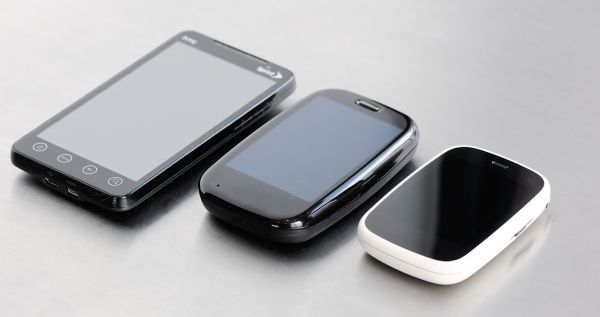
Left to right: HTC EVO 4G, AT&T Palm Pre Plus, HP Veer 4G
The Veer is essentially a ground-up refresh of the Palm Pixi. The two share the exact same 2.63 inch diagonal 320x400 sub HVGA LCD display and button-less gesture area. Where the two differ is surrounding form factor - the Veer abandons the candybar format in favor of the portrait slider carried by the original Pre, and as a result has a much smaller outline. The Veer will come in both black and white.
In addition the Veer is built around a much speedier SoC, Qualcomm's 800 MHz MSM7230 with Adreno 205 graphics, same as we first saw in the T-Mobile G2. It isn't quite as fast as this generation's 1 GHz frontrunners like Hummingbird or even MSM8x55, but MSM7230 makes the device substantially faster than the Palm Pre Plus I carried around for a while. On paper the Veer should perform better than the Pre Plus and Pixi, but behind the Palm Pre 2 and HP Pre 3. My mental comparison point is the Palm Pre Plus, and compared to it, everything on the Veer is smoother and faster.
The other big differentiator is the move from a 2 MP to 5 MP camera, though the optical system is still fixed focus. Thankfully capture is still incredibly speedy - you can still mash the capture button and snap a bunch of pictures in rapid succession.
We've run a few of our web benchmark tests from the usual suite and have results, but expect to see a lot more in the full review.
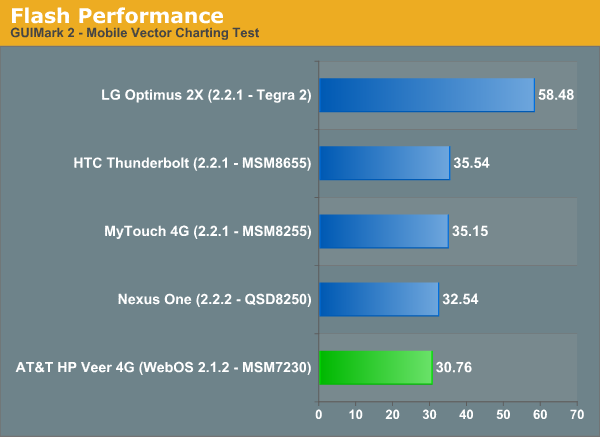
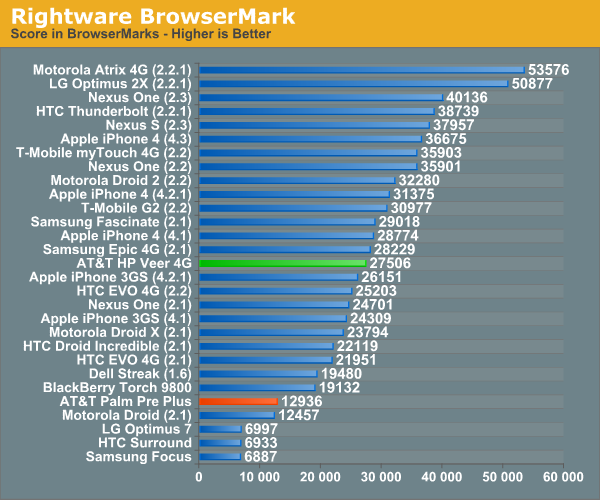
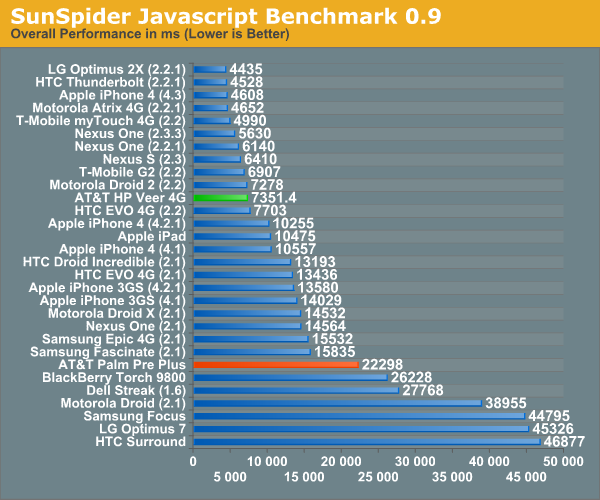
First impressions with the HP Veer are overall very good. Build quality is solid, as the Veer has a very sturdy feeling slider with none of the "oreo effect" that plagued the original Palm Pre for so long. In addition, the Veer also lacks the LCD pressure distortion that used to occur when the slider was closed sharply. The entire mechanism feels snappy and precise with absolutely no play. Buttons are clicky and responsive, nothing suffers from miniaturization thankfully. I've been using the Veer all day today with my own SIM inside (just like I do for every phone when appropriate) and thus far am impressed with how useable the whole thing is despite the miniaturized keyboard and relatively small display.
The only compromises the Veer does make as a result of its miniscule size are lack of a microUSB port and 3.5 mm audio jack, and a non-replaceable 910 mAh (3.3 Whr) battery. For USB connectivity and audio out, there are two proprietary magnetic adapters very reminiscent of Apple's MagSafe. We'll subject the Veer to our suite of battery life tests immediately and find out how much stamina the Veer has with such a small battery.
We've taken a bunch of photos of the Veer alone and alongside its larger predecessor and put them in a gallery for your perusal. Stay tuned for the full review later this week.


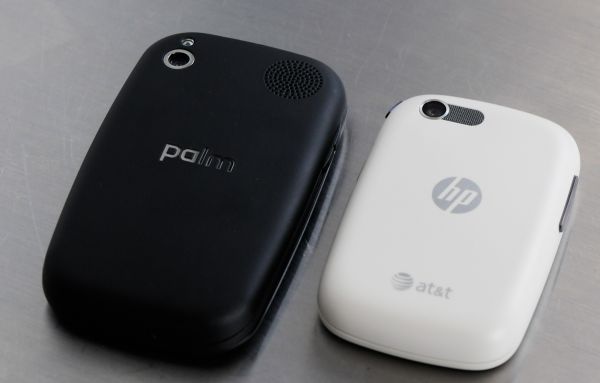















28 Comments
View All Comments
tviceman - Tuesday, May 10, 2011 - link
Has HP indicated whether or not their future webOS phones will come to Sprint? I refuse to switch to AT&T with their higher monthly usage fees and data caps.KaRRiLLioN - Tuesday, May 10, 2011 - link
If only an Android phone with a portrait slideout keyboard would come out. I used to have a Palm Treo and loved the physical keyboard. The phone otherwise sucked for anything other than talking or texting.I just refuse to get a phone with an OS that's lacking a decent app store. Maybe HP will admit WebOS is a lost cause and go to Android.
dcollins - Tuesday, May 10, 2011 - link
It's a little dated, but the Motorola Droid 2 has an excellent physical keyboard. You can actually get one for free with a new contract from Verizon.Mine is flashed with Liberty ROM 2.0 and overclocked to 1.45Ghz when fully charged (under-clocked to 400mhz when <25% charge). It's an excellent phone once liberated from motoblur.
cptnjarhead - Tuesday, May 10, 2011 - link
good review.precentral did a comprehensive review and all in all the veer makes a good showing.
I still like my pre+ OC'd @ 1ghz runs great, still waiting for pre 3 or stingray (crossing fingers)
http://www.precentral.net/keyboard-less-webos-phon...
Crono - Tuesday, May 10, 2011 - link
The Veer looks like it borrowed its styling from the Kin One.wewter - Tuesday, May 10, 2011 - link
or from it's ancestor the pre ...considering the pre outdates the kin by almost a full year
google next time and don't waste our time.
worldbfree4me - Wednesday, May 11, 2011 - link
That speed is about what I'm seeing on my EVO while employing 4g. However I did see 10.5 mbps last night! I find that while I'm tethered up to my iPad, videos stream pretty well at between 2 and 4 mbps.zephxiii - Thursday, May 12, 2011 - link
Thanks for the investigation and write up on the HSPA+ stuff Brian!I was wondering if you had a list of the supported Rel. 7 features of the Qualcomm and SE chips in the Atrix, Inspire, and Infuse. Stuff like CPC, enhanced Cell_FACH/PCH, Voice over HSPA (as Qualcomm puts it), DL interference cancellation and whatever else.
Also does the Infuse 4g have the same chip in the new Galaxy S2s?
There is also the flat IP architecture that comes into play with HSPA+ that allows for data to by pass certain parts of the infrastructure for more direct routing. T-mobile's HSPA+ has shown some impressive latency results that *could* be a result of that. AT&T isn't quite down there with T-Mobile yet but interestingly I've seen a couple wiffs of lower latency in a market here and there....just something else to keep an eye out for.
Thanks!